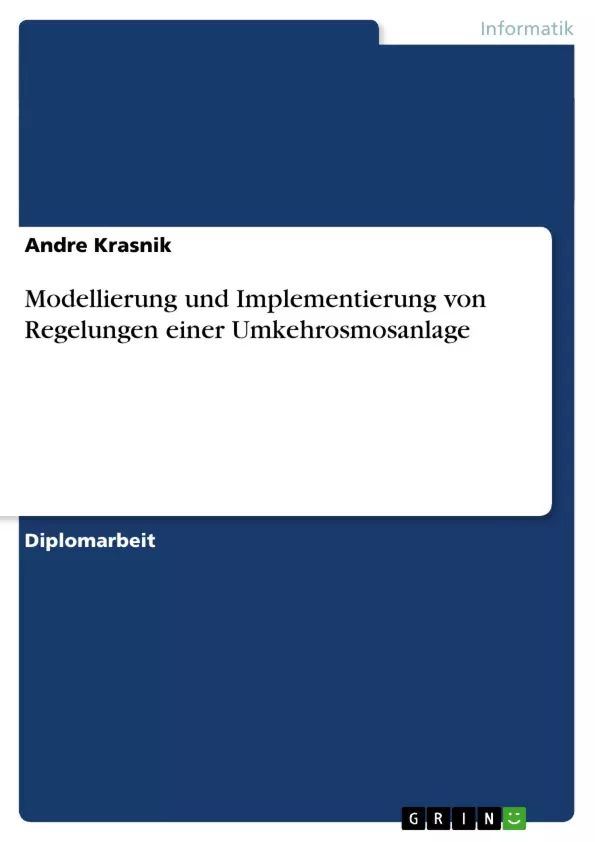In the context of this diploma thesis the following tasks should be solved:
- to develop a mathematical model of a continuously working OSMO ECO reverse
osmosis plant of the company OSMO SISTEMI (Italy);
- to implement this mathematical model as an input/output system with assistance of
Matlab/Simulink/Stateflow;
- to validate the Matlab/Simulink/Stateflow model with the OSMO ECO reverse
osmosis plant;
- to test different controls at the model and discuss results.
Because of the influence of unforeseeable events these tasks were changed. It does
not become the OSMO ECO reverse osmosis plant specified above, but on the basis
fixed characteristics a new system was theoretically designed. The following must be
considered thereby: According to the possibility with only one reverse osmosis unit
from the dirty water (max. 10000 ppm TDS) get as much as possible pure water (TDS
< 150 ppm).
There are different kinds of RO units. Here, only two usually common types of RO–
modules are considered: the hollow fiber module as well as the spiral wounded
module. The obtained simulation results as well as the model based controller design
carried out by using the model, which was developed in this work, are satisfactory
and open several perspectives for the future work. Because the plant was not
available during the development of this work, it was not possible to compare the
results of the simulation with the data from the real plant.
Inhaltsverzeichnis
- Einleitung
- 1. Die verfahrenstechnischen, chemischen, physikalischen und regelungstechnischen Grundlagen
- 1.1 Struktur von Flüssigkeiten
- 1.2 Wasser als eine chemisch-physikalische Lösung fester Stoffe
- 1.2.1 Definition einer Lösung und ihre allgemeinen Eigenschaften
- 1.2.1.1 Konzentration und molare Masse
- 1.2.1.2 Chemische Potential und Löslichkeit
- 1.2.1.3 Volumen, thermodynamische Temperatur
- 1.2.1.4 Der osmotische Druck
- 1.2.1.5 Nichtideales Verhalten konzentrierter Lösungen
- 1.2.1.6 Osmolarität
- 1.2.1.7 Leitfähigkeit von Elektrolytlösungen
- 1.2.1.8 Definition von pH-Wert
- 1.2.2 Die Stoffbilanzgleichung für den Transport des Stoffes im Fluid: Diffusion und Konvektion
- 1.2.3 Die Impulserhaltung für das Verhalten von Strömungen in inkompressiblen Flüssigkeiten
- 1.3 Das Membranenelement
- 1.3.1 Selektiv permeable Membran und ihre allgemeinen Eigenschaften
- 1.3.1.1 Selektivität, Fluss und Rückhalt
- 1.3.1.2 Transportwiderstände an der Membran
- 1.3.2 Strukturen, Werkstoffe und Herstellung von organischen synthetischen festen nicht porösen assymetrischen Membranen
- 1.3.3 Klassifizierung von Membranelementen nach Konstruktion
- 1.3.3.1 Das Hohlfasermodul
- 1.3.3.2 Der Spiral-Wickelmodul
- 1.3.4 Membranbeständigkeit und -verblockung infolge von Scaling und/oder Fouling
- 1.4 Entwurf linearer Regelungskreise
- 1.4.1 Empirische Einstellregeln für PI-Regler nach Ziegler und Nichols
- 1.4.2 Entwurf linearer Regelungskreise im Zustandsraum
- 1.4.2.1 Steuerbarkeit und Beobachtbarkeit linearer Systeme
- 1.4.2.2 Zustandsgrößenrückführung
- 1.4.2.3 Zustandsgrößenrückführung mit zusätzlichem I – Regler
- 1.4.3 Stabilität linearer Systeme
- 2. Methoden von Wasserentsalzung
- 2.1 Thermale Verfahren
- 2.1.1 Mehrstufige Entspannungsverdampfung
- 2.1.2 Solare Wasserdistillation
- 2.1.3 Thermische Entsalzung mit Niedertemperaturwärme
- 2.2 Membranverfahren
- 2.2.1 Umkehrosmose
- 2.2.2 Elektrodialyse
- 3. Betriebsparameter und die Funktionsweise einer Umkehrosmoseanlage
- 3.1 Betriebsparameter einer Umkehrosmoseanlage
- 3.1.1 Feed-Salzgehalt und der transmembrane Druck
- 3.1.2 Einfluss der Feed-Temperatur
- 3.1.3 Permeat-Rückgewinnungsfaktor
Zielsetzung und Themenschwerpunkte
Die vorliegende Diplomarbeit befasst sich mit der Modellierung und Implementierung von Regelungen einer Umkehrosmoseanlage. Ziel ist es, ein mathematisches Modell der Anlage zu entwickeln, dieses in Matlab/Simulink/Stateflow zu implementieren und das Modell mit der realen Anlage zu validieren. Darüber hinaus sollen verschiedene Regelstrategien am Modell getestet und die Ergebnisse diskutiert werden.
- Modellierung einer Umkehrosmoseanlage
- Implementierung des Modells in Matlab/Simulink/Stateflow
- Validierung des Modells mit der realen Anlage
- Test verschiedener Regelstrategien
- Diskussion der Ergebnisse
Zusammenfassung der Kapitel
- Einleitung: Die Einleitung führt in die Thematik der Diplomarbeit ein und erläutert die Motivation für die Arbeit.
- Kapitel 1: Dieses Kapitel behandelt die verfahrenstechnischen, chemischen, physikalischen und regelungstechnischen Grundlagen, die für das Verständnis der Funktionsweise einer Umkehrosmoseanlage relevant sind.
- Kapitel 2: In diesem Kapitel werden verschiedene Methoden der Wasserentsalzung vorgestellt, wobei der Schwerpunkt auf dem Membranverfahren der Umkehrosmose liegt.
- Kapitel 3: Dieses Kapitel befasst sich mit den Betriebsparametern und der Funktionsweise einer Umkehrosmoseanlage.
Schlüsselwörter
Die wichtigsten Schlüsselwörter der Arbeit sind: Umkehrosmose, Modellierung, Regelung, Matlab/Simulink/Stateflow, Membranverfahren, Wasserentsalzung, Betriebsparameter, Hohlfasermodul, Spiral-Wickelmodul.
- Quote paper
- Dipl.-Ing (FH), Dipl.-Inf. Andre Krasnik (Author), 2006, Modellierung und Implementierung von Regelungen einer Umkehrosmosanlage, Munich, GRIN Verlag, https://www.hausarbeiten.de/document/87582


